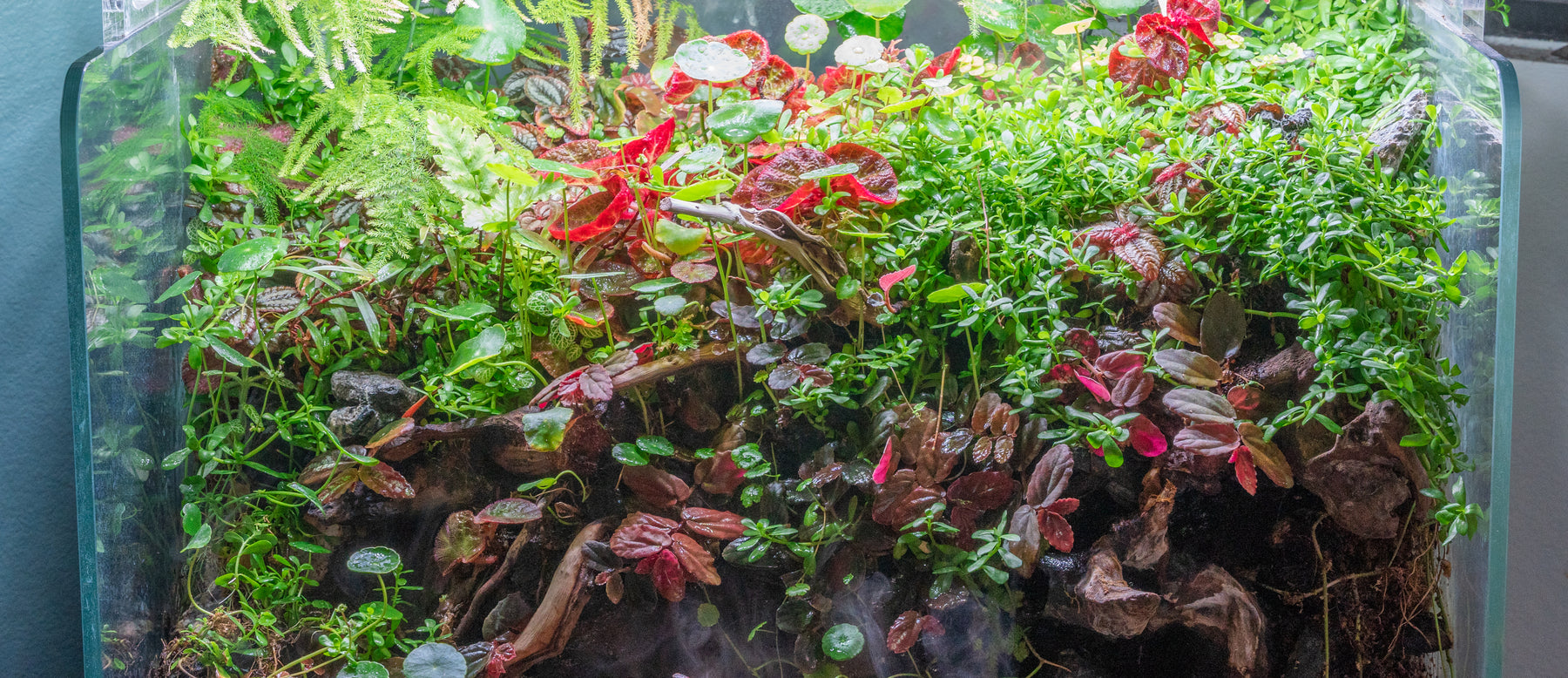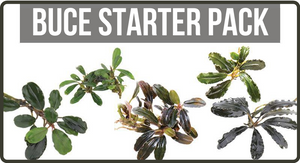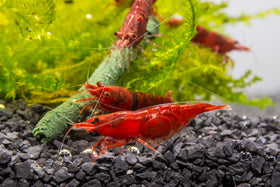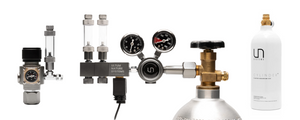
5 Aquarium Plants That Make the Terrarium Cut
You may already be familiar with the amazing versatility of aquatic plants normally used in freshwater aquariums.
But did you know that many of these plants can also make the jump completely emersed (out of water) too? Naturally, that makes many popular "aquarium" plants fantastic candidates for a terrarium as well.
Out of the water, these plants retain much of their versatility. They can be easily attached to driftwood branches, rocks, and even the terrarium background itself. Taking advantage of 3D planting opportunities to - literally and metaphorically - elevate the visual experience of a planted tank.
Here's why you should consider semi-aquatic plants for your next nature project, and a list of some of the best plant species to get you started.

Using Aquatic Plants in Terrariums
Advantages
- They're stable and reliable - Many of these plants are commercially farmed under emersed conditions in small, sealed pots. So you can be sure that they're suited to growing in the moist, humid conditions of a terrarium.
- They're often small and slow-growing - The aquascaping industry has cultivated a wide range of small, slow-growing plants for use in the hobby, and the needs of a terrarium are much the same.
- They look even better (when grown exposed to the air) - Thanks to the abundant source of CO2 in the air vs. underwater, many of these plants will grow more vibrant and lush foliage than their submerged counterparts.
Considerations
Maintaining a high humidity is essential in keeping these semi-aquatic plants happy in a terrarium or a paludarium setup.
They'll quickly dry out and wither in low moisture and/or low humidity environments. As opposed to true terrarium plants, they may need some specialized care conditions that will largely depend on both the plant species and how you plant them.
- Attach epiphytic plants directly to hardscape. For semi-aquatic epiphytes that cannot have the rhizome buried, fitting them directly onto rock or wood remains a great option out of the water. Glue or a thread tie can help fix them in place. For some live plants, small chunks of moist sphagnum moss bundled into the crevices beneath them can help to provide a further reservoir of moisture.
- Sidenote: Although these plants are commonly referred to as "epiphytes" in the aquascaping hobby, this may not be scientifically accurate. Instead, many of them are considered to be rheophytes. Learn more about this in our article, "Epiphyte or Rheophyte... Which Is It?"
- Planted terrestrially. Some aquatic plants can be planted up natively in a terrarium (I'm looking at you, Cryptocoryne), but many can't so be sure to check the specific care requirements of each plant. There's also a middle ground of "planting" on top of a moist substrate to explore.

With all of these planting options, proper drainage is essential.
Any plants that are exposed without direct access to moisture (e.g., Java Moss applied to rock), especially in an open terrarium, will need to be misted regularly. This can often mean you're adding a little too much water to the system for your other plants, so it's a tricky process.
Not to mention the effect of your tank choice. Closed terrariums can trap moisture and generate humidity, but vented enclosures might need a professional misting system to achieve the same effect.
Alternatively, if you're going for a more advanced setup, you can get really creative. How about exploring the idea of running water washing over your epiphytes via a waterfall (like the one pre-installed in the UNS Foresta) or fogger?
The Best Aquatic Plants for Terrariums
1. Bolbitis

Despite being named the "Asian Water Fern," these plants are surprisingly good out of water too.
With their herb-like dainty fronds, Bolbitis heteroclita can slot in nicely to provide some texture to a wide variety of terrarium areas. They're ideal for planting like an epiphyte into the crooks of hardscape branches.
In fact, opting for the Mini Bolbitis variety could be the most versatile choice. Its small size and slow-growing nature make it a natural fit for smaller terrariums across the board.
2. Cryptocoryne

Found naturally growing in areas of changing water levels, plants of the Cryptocoryne genus have adapted to grow in a wide variety of water conditions.
That means they are great when attached to a surface like epiphytes - both in the water and out - and they can even be planted directly into (moist) terrarium substrate too. There's nowhere in a terrarium these can't go!
- For epiphytic planting, the small grass-like Cryptocoryne Parva is an excellent choice. With a max height of around 4 inches tall and an extremely slow growth rate, it's unlikely to outgrow its spot.
- Whereas for terrestrial planting, you can get away with a much wider range of Crypt species. The bright foliage of Cryptocoryne Wendtii Green is popular amongst beginners and could be a great place to start.
3. Anubias

Anubias is a family of epiphytic plants with stunning dark emerald foliage.
In a terrarium, they can provide some wonderful visual contrast, but you'll need to use them wisely. Keep in mind that even when placed out of the water, they still can't have their rhizome buried.
You'll need to attach them to hardscape just as you would underwater. For more information on how to properly plant Anubias, check out this article on how to plant epiphytic aquatic plants.
Opting for the smaller varieties - such as the Anubias Nana Petite - is a good idea for most terrariums. Out of the water, you now need to contend with the full power of gravity, and attaching bigger epiphytes can get tricky on thin branches.
For the smaller plants, you can simply bundle them into appropriate spaces in hardscape (they're fairly chunky and firm), but you may need to tie on the larger ones with thread (e.g., Foresta Line).
As time goes on, the strong roots of the Anubias will begin to cling onto their surroundings better, and you can remove any supporting threads.
4. Bucephalandra

Naturally, this list could not be complete without the inclusion of the fan-favorite Bucephalandra.
A large family of easy-to-grow plants that's full of diversity and iridescent colors. Many are compact and slow-growing, so there's a lot to choose from for terrarium usage.
Similar to Anubias, these Borneo natives have developed strong roots - making them great for attaching to those challenging hardscape areas. They can even flower too! So they're arguably a viable alternative to orchids when used correctly.
When it comes to choosing varieties, we're truly spoilt for choice. With everything from crinkled leaves to blue and purple foliage on offer, it really is a matter of preference.
For epiphytic applications, the smaller Bucephalandra Kedagang Mini seems a natural fit, but there are plenty of other smaller varieties available.
5. Mosses

Semi-aquatic mosses like Java Moss can really bring a terrarium hardscape to life.
Under the right conditions, they can form a thick blanket of lush green moss all over your driftwood branches and rocks. Though keeping it happy long term can be tricky, but not impossible.
You need to be pushing 100% humidity at all times to keep this moisture-loving plant happy. Mounting it on top of sphagnum moss can help to provide more consistent moisture, as sphagnum retains moisture quite well.
The terrariums that grow Java Moss best tend to be the larger tank terrariums that are regularly misted (typically with a misting system, but not always) or utilize an atomizer. That way, they get consistent moisture along with some airflow too.
Christmas Moss is another great choice here that performs in much the same way.
In conclusion, using aquatic plants in terrariums is a great way to add some visual interest and depth to your terrarium. Many popular aquarium plants can make the jump completely emersed, retaining much of their versatility out of the water. Whether you are attaching them to driftwood branches, rocks, or the terrarium background, aquatic plants offer unique planting opportunities that can elevate your terrarium setup.
To explore more aquatic plants, check out our huge selection of fresh picks here.





Comments
Leave a comment